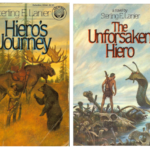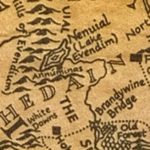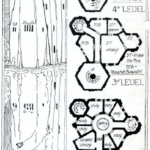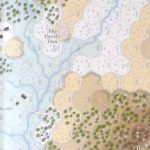As mentioned in my previous post about a long-running Gamma World campaign, the maps increasingly became more detailed and linear to meet the needs of the game. This set of maps was pretty much the second phase of the campaign after the players had confronted the threat posed by the Unclean and turned their attention to the lands inhabited by the Death Groups, a combination of the nomadic aspects of the Red Death cryptic alliance (thus the name, but with the extermism subsumed by the group known as the Seekers of the Red Sword) and the willingness to live in radioactive areas like the Radioactivists (and thus having access to higher technology, like the Unclean, but with less infrastructure to take advantage of it, due to their nomadic society).
Continue reading
Category: Games (Page 3 of 3)
One of the longest running campaigns I’ve ever run was a Gamma World game based on the original first edition rules. In building the world, I used not only elements from the setting sketched out in the book, but elements from other game settings like The Morrow Project and Aftermath along with ideas from film and fiction. The most direct lift was the territory controlled by the Eleveners, a direct lift from Hiero’s Journey by Sterling E. Lanier and its sequel, though the actual details of their society included elements from Miller’s A Canticle for Liebowitz and was a combination of Healers and Restorationists as presented as Cryptic Alliances in the setting. Lifewise, the Brotherhood of the Unclean became simply The Unclean as the dark side to the Restorationists with a healthy dose of other antagonists thrown in including, most predominantly, Radioactivists.
The maps of Middle Earth have always held a special place with me, whether it’s been the original maps by J.R.R. Tolkien himself, the version by Pauline Baynes from the calendar that I owned once upon a time, or the detailed maps by Karen Wynn Fonstad that appeared in her Atlas of Middle Earth. The idea of a world with depth and history is always appealing and I must have explored every corner of the world, not only following the path of the Fellowship, but also the places mentioned in the stories or shown on the maps that were peripheral to the saga.
Of particular note was the lost kingdom of Arnor and the remains of its capital city, Annúminas, on the southern shore of Nenuial, also known as Lake Evendim. This is, without a doubt, my single most favorite place in Middle Earth. As the ruins of a once-great city, it barely merits a footnote in the story apart from being a special place to the Rangers of the North, the descendents of the northern Dúnedain.
Which brings us to Pete Fenlon and his work over a decade and a half working at Iron Crown Enterprises working on their Middle Earth roleplaying game and the numerous supplements detailing parts of the world, expanding on the works of Tolkien, and creating new adventures. Many of us were inspired by his work and have so many great memories of each and every map. The Pete Fenlon style has influenced not just gamers like myself, but other map designers, as well.
Continue reading
One of the most difficult things with maps, particularly in those for roleplaying games, is capturing three-dimensional spaces. Since the early days of computer games like Colossal Cave Adventure and various dungeon delves, the result is the flattening of complex structures onto two-dimensional planes.
My experiences as an early gamer were rather insular and even TSR’s Dwellers of the Forbidden City (I1) passed me by at the time, much like many of the works out of the UK including the Pellinore game setting. As a result, I think my first exposure to isometric maps were the ones from the Dragonlance adventures and those blew my mind.
Hex maps are a staple of games, a way of describing a chaotic surface in a way that facilitates play by abstracting that surface to a degree that’s easier and simpler than it would otherwise be. As an old-time gamer, I confess to a soft spot for hex maps, whether it’s the simplicity of the terrain as modelled in the original Panzer Blitz and Panzer Leader, or the use of hexagons to show distance in above-ground maps for roleplaying game settings like The World of Greyhawk (TSR) and The Wilderlands of High Adventure (Judge’s Guild).
At their best, hex maps combine an ease-of-use with a wealth of detail that makes them both functional as game maps while simultaneously conveying that functionality in a visually-pleasing fashion that makes clear what’s being represented.
By way of example, consider the Battle of Gettysburg and the challenges it presents to a wargame designer. How best to represent key areas like Devil’s Den, an area littered randomly with boulders and trees, and overlooked by Little Round Top? The somewhat unique character of the terrain gave the struggles in that area a different feel and something to be captured on a map as something more than a rough terrain hex. The same can be said for many unique features, either specific to a particular battlefield or to a theater of operations, be it the bocage of Normandy or the factories of Stalingrad, to name but a couple.
Which brings us to Redmond A. Simonsen, one of my absolute favorite map designers whose credits span a myriad genres of wargames. I’m not sure which of his maps I fell in love with first, but most span the same era (1977-1981, the heyday of Simulations Publications, Inc. (SPI)).
While I’m not a hard-core fan of the Halo video game series, I’ve certainly played my fair share of the franchise, read the books and more. While working on Crimson Skies XBox title, we had the privilege of looking at the controller scheme and played quite a bit of multiplayer LAN matches of the first Halo game as a break from the game we were developing (those of us who weren’t playing Battlefield 1942).
As a result, though, there’s a bit of bias in my enjoyment of the Forward Unto Dawn web series that’s prefacing the release of Halo 4. The series follows a group of cadets training to fight the insurrectionists right when the Covenant launches its first attacks. Seen from the eyes of these ordinary people, Orbital Drop Shock Troopers (ODSTs) are regarded with a certain degree of hero worship, but when we’re introduced to the Covenant and the appearance of a Spartan, we see them all in a different light. In particular, the Covenant Elites are rather terrifying and their appearance in the show makes for great drama.
Continue reading
Watching card manipulation by Dan and Dave Buck including those on their site like the demo video of the Akira flourish got me thinking quite a bit about card shuffling. After seeing some of the false shuffles and other manipulations and having read about games where the shuffling algorithm was only pseudo-random, I wanted to make sure that the card shuffling for my game was at least adequate enough to make the game work. If you’re not familiar with Dave and Dan, check out this video advertisement for their set of DVDs over at Theory 11.
Wikipedia has a good article discussing shuffling cards and computer algorithms for shuffling.
An example shuffle algorithm in Javascript would be this implementation of Durstenfeld’s algorithm, a modern version of Fisher-Yates that looks like this:
function array_shuffle (aArray) { var i, j, mTemp; for (i = aArray.length; i;) { // mTemp, j initialized here for shorter code. j = parseInt (Math.random () * i); mTemp = aArray [--i]; aArray [i] = aArray [j]; aArray [j] = mTemp; } } |
For the random number generation, I prefer this, but I haven’t exercised it in order to see if it makes a difference, though seeing parseInt in the above makes me wonder about its presence.
j = 1 + Math.floor(Math.random() * i); |
As for the cards in the game, they are represented in the Javascript as objects and can be either people or actions. People cards are members of one or the other faction or a third group of loosely-aligned Romans who may be swayed to one side or the other. They have attributes including the side they belong to, whether their side may be changed, their name and current rank. Action cards represent the cards that are used during play. Actions include ranks and positions that may be assigned to People and events like riots, assassinations, and plagues. Action cards often have negative or side-effects, sometimes costing the player who uses it as much as his opponent. Other cards require votes from the Senate such as Exile or the appointment of Generals.
There are a variety of collections that I’ll refer to as decks. There are two decks of people, one for each player. Event decks include one hand for each player, the drawing deck and the discard deck. Additionally, there may be individual cards in play that belong to no particular deck.
I considered a number of names for the game including Optimates et Populares, but that doesn’t roll off the tongue. The working title that I came up with is
I’ve decided to create a web-based game set in early Rome. It’s intended to be about the leaders of the time with an emphasis on politics rather than military strategy. I want the latter to happen “off-screen” as it were, but with the option for legions to show up at the gates of Rome when needed to influence political events.
The biggest difficulty was selecting a time period that provided the right amount of variety, particularly political in-fighting and manuevering without too much military action (such as the wars with Carthage). In that regard, the early and late periods of the Republic offered some interesting options, as did the time of the First Triumvirate and the period following the death of Caligula, to name but a few points in the turbulent history of the Romans.
I’m particularly fond of the political manueverings described in Imperium by Robert Harris and in the BBC production of I, Claudius (for which I must confess that I haven’t read the book by Robert Graves). There’s an immediacy to the politics combined with a certain degree of brutality that keeps one from longing overmuch for the good old days. So the more I thought about it, the less Imperial Rome appealed to me and the more I wanted to go back a little further in time. At the same time, Lavinia by Ursula Leguin brings the events of Virgil’s Aeneid to life brilliantly with the interplay between the tribes of the area and the followers of Aeneas.
Out of all the time periods that I think would make for an worthwhile game, the period immediately following the Social War, a crisis point in Roman history, sounded extremely interesting. Sulla’s First Civil War with the struggle between the optimates and populares (and I’m simplifying matters greatly since it wasn’t that black and white) made for some turbulent times with lots of political and military manuevering. Throw in assassinations, exiles, plagues, riots and external threats like Mithridates of Pontus, and you have a good deal of elements to work with.
As they say, plus ça change, plus c’est la même chose. The politics of the Roman Republic and the Roman Empire have much in common with the infighting during the War of the Roses and the gangland warfare of the Roaring Twenties. For that reason, I wanted to capture some of the feel of the Avalon Hill game Kingmaker, minus the board and tediousnous of moving armies around, with the fast-paced play of Family Business, but with a more historical feel and slightly more elaborate mechanics.
Before starting work, I did some research on already existing games that covered both the time period I was interested in with the politics in a card game or simple board game version. I was positive there’d be a plethora of games of all stripes, some very similar to what I had in mind. Surprisingly, the list wasn’t nearly as long as I expected, though I’m sure I missed more than a couple. My short list of games that aren’t strategy games and that otherwise capture some of the elements I was looking for are as follows:
- Caligula from Post Scriptum/Elfinwerks
- Republic of Rome from Valley Games Boardgame
- Caesar & Cleopatra from Rio Grande Games
- Glory to Rome from Cambridge Games Factory
- Sword of Rome from GMT Games
- Quo Vadis from Mayfair Games
- Rome is Burning from Warp Spawn Games
- Sylla from Ystari Games
- Tribune: Primus Inter Pares from Fantasy Flight Games
- Triumvirate from Indie Boards and Cards
Certainly, some of these games are ones that I’d really like to play, particularly Triumvirate. But before I do that, I’d like to get my game up and running. First up, a paper prototype. Much like website usability testing with paper mockups and wireframes, I plan to make some cards and to try some mechanics so I can see how they play out. I’ll discuss that in my next on this subject.
A month ago, I updated my LinkedIn profile to say I was, “…playing and making some games.” I’ve had a few game ideas kicking around and the games I’ve been playing lately have gotten me a bit more motivated to work on my own ideas. My thought was that this small declaration would keep me moving forward and I would actually make some headway on at least one project. As others have noted, ideas are cheap, but seeing a project through to completion is considerably more difficult.
What I hadn’t anticipated was a co-worker asking me what kind of games I was working on. Since my day job is in web development for an HMO, my co-worker was unaware of my background in game design and my continuing interest in doing that kind of work. However, the reason I’m not employed full-time doing game design has more to do with the nature of industry, particularly the crazy hours and my daughter being of an age where she started to think daddy lived in the phone. At the time, people were beginning to take a hard look at some of practices and work environment that went with game development, the most visible being the story of EA Spouse. Just as a case in point, the agency I contracted through gave me vacation time that accrued at a rate of 2 weeks per year based on hours worked. In my first contract, between overtime and the occasional all-nighter, I accrued four weeks of vacation.
So, though I’m not working in the game industry as my day job, I’m still very much interested in games. But my co-worker’s question raised an interesting point: What is the definition of game? Her assumption was that, as a computer guy, I would be turning my energies toward some form of computer game. But even that’s a pretty broad range, given the proliferation of casual games, many of them web-based, alternative reality games, that incorporate many forms of technology including web pages and other technology, and console games, developed on computers despite the hardware being rather specialized.
However, I also play pen-and-paper roleplaying games (Dungeons and Dragons and Ars Magica, among myriad others), I am guilty of having played live-action roleplaying, and I play boardgames, given the opportunity. In fact, about the only thing I don’t play is fantasy football and its real-world team sports analogues.
So, while I’m not planning on creating something like BASEketball any time soon, I’m casting my net considerably wider than trying to develop the next version of Duke Nukem Forever (figuring whatever game I work on still probably has a better chance of seeing the light of day).
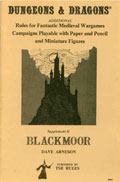 There have been many game designers and creators of game systems who I admire, but few as much as Dave Arneson. So I was saddened to hear he had passed away last week on April 7th. For someone like me who remembers the original three book Dungeons and Dragons books (as do many others), the Blackmoor supplement remains one of my favorites of all time and the first setting to really capture my imagination and to hold it more than the many others over the years.
There have been many game designers and creators of game systems who I admire, but few as much as Dave Arneson. So I was saddened to hear he had passed away last week on April 7th. For someone like me who remembers the original three book Dungeons and Dragons books (as do many others), the Blackmoor supplement remains one of my favorites of all time and the first setting to really capture my imagination and to hold it more than the many others over the years.
Matt Blum wrote in his Wired Magazine column, “It was Arneson’s spark that transformed Gygax’s game Chainmail into the first edition of D&D, and begat everything that followed.” In his career, he was a man of many talents, combining a love of games not just as the developer of D&D, but as a teacher and creator in other mediums including computer games. In the Star Tribune (article no longer available), his daughter said, “…her father enjoyed teaching at Full Sail University in Winter Park, Fla., in recent years, where he inspired future game creators, and taught students to make a solid set of rules for their games.” His approach to games makes more sense to me than that of other designers and probably why some of my earliest favorite computer games tend to resemble computer versions of Arneson’s Temple of the Frog, among them games like Telengard, Temple of Apshai and Wizardry. There are some great insights in this previously unpublished interview with Dave Arneson from 2004.
Though’ll he’ll be missed, we’ll always be grateful for the person he was and the legacy he left. It’s truly a great one.
